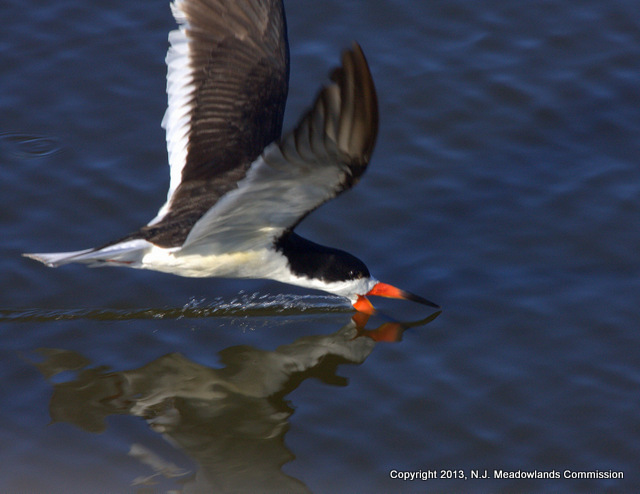 Jim Wright, who maintains this blog for the Meadowlands Commission, also writes a column for the South Bergenite on the second and fourth Thursdays of the month. His latest is on this year’s bumper crop of Black Skimmers.
Jim Wright, who maintains this blog for the Meadowlands Commission, also writes a column for the South Bergenite on the second and fourth Thursdays of the month. His latest is on this year’s bumper crop of Black Skimmers.
Now is the time of year to see an amazing bird called the black skimmer in the Meadowlands, and this is a year when they seem to be incredibly plentiful.
Considering that these large black-and-white shorebirds are an endangered species in New Jersey, the frequent sightings being reported across the Meadowlands are all the more impressive.
Last week alone, these birds were seen fishing in DeKorte Park and the Clay Avenue Wetlands in Lyndhurst, in Mill Creek Marsh in Secaucus, and along the Hackensack River from Carlstadt to Kearny.
But these guys, with their bright red and black bills, don’t fish like most other avian anglers. Herons and egrets, for example, wade in the water and grab fish with their pointy bills. Belted kingfishers hover, then crash into the water to seize their prey. Ospreys hover as well, then dive into the water and grab the fish with their talons.
Black skimmers, on the other hand, live up to their name. They skim.
NJMC Naturalist Mike Newhouse explains: “The Skimmer catches fish with its large bill — with the lower mandible being larger than the top — as it clips the surface of the water while it is flying.”
What’s more, black skimmers tend to fly in groups (in tight formation) and in silence. Thus, the sight of skimmers quietly gliding along is an experience not unlike watching the U.S. Air Force’s Blue Angels flight team.
Also, Newhouse notes, skimmers feed at any time of the day.
“The cool thing is that they are mostly crepuscular — active during dusk and dawn — but also can feed in the middle of the night because they use their sense of touch with their bill, which will snap shut when it touches a fish.”
The time to watch for skimmers is now, says Newhouse: “They tend to be in the Meadowlands for the majority of June, and then start becoming harder to find in July, when they head for the southern U.S., Mexico, or South America.”
I never got a decent look at a skimmer until my second summer working in the Meadowlands — and then it was about a minute’s worth, in the Shorebird Pool at DeKorte Park.
I finally got my first and only up-close look the following summer (see photo at top) when retired NJMC Naturalist Don Smith found a dazed skimmer in Secaucus.
I drove the bird to The Raptor Trust in the Great Swamp, where it was successfully rehabbed. We later released it near Laurel Hill County Park in Secaucus.
I like to think that one of those avian Blue Angels we see now is the guy we saved.
